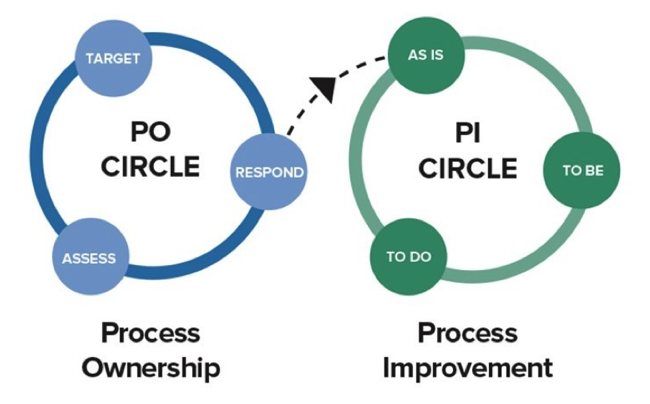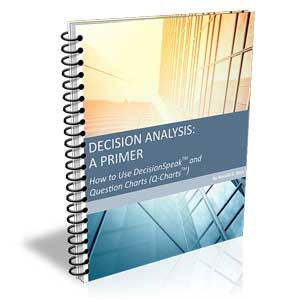Wiggle, Wobble, and Well
• What would good look like? (WWGLL).
• What would bad look like? (WWBLL).
• What would exceptional look like? (WWELL).
In process analysis and improvement work, a lot of attention is rightly paid to the first of these questions. Nowhere near enough attention is paid to the other two. This month, Roger Tregear takes a holistic look at all three, illustrating how 'else analysis' can be used to push the limits of performance.
Three important questions for process (as for life, the universe, and everything):
- What would good look like? (WWGLL).
- What would bad look like? (WWBLL).
- What would exceptional look like? (WWELL).
In process analysis and improvement work, a lot of attention is rightly paid to the first of these questions. Nowhere near enough attention is paid to the other two.
An effective process improvement mindset, i.e., one that will deliver organizational performance improvement, pays continuous attention to all three questions across all nodes of the Tregear Circles.

Target sets the process KPIs and targets. Assess considers performance data and ideas for change. At Respond, decisions are taken based on the performance gap analysis. Where appropriate, the PI Circle works out how to capitalize on ideas and fix or avoid problems — all the time trying to find the right balance between the good, the bad, and the exceptional.
WWGLL?
What would good look like?
This is a simple idea and question that is fundamental to process management and improvement. It's shorthand for the standard process performance question:
If this process was performing as well as its key stakeholders want it to, what would it be doing and how would we know?
To answer the question, identify the stakeholders and ask them. Life doesn't have to be complicated!
In those conversations seek to also understand the why. What does good performance allow to happen? How have they arrived at their definition of good performance? What makes a particular level of performance "good"?
Good process management that leads to good process improvement is greatly facilitated by deep knowledge of the process and its ecosystem.
WWBLL?
What would bad look like?
This might seem like an unusual question to ask; perhaps it feels counterintuitive to focus on poor performance — useful though to establish the ends of the performance spectrum. This also allows the current performance to be located on the WWGLL-WWBLL scale, giving a better sense of what level of performance improvement might be possible.
To uncover practical answers to this important question, ask another one. If you had the opportunity to design the worst possible version of this process, what would be its main characteristics?
As in the WWGLL conversations, seek to understand not just the 'numbers' but the impact of bad performance. What would be the knock-on effects of the resulting poor performance? It might be that the negative impact in this process is greatly surpassed by the impacts on other processes in the ecosystem.
Focusing on the WWBLL question gives a more nuanced understanding of what is important about the performance of the process and why. Along with the WWGLL question, it allows assessment of the potential impact of the process and how sensitive organizational performance is to the performance of this process.
Of course, it is to be hoped that the answer to the WWBLL question isn't describing the current process operation!
WWELL?
What would exceptional look like?
This is a much-neglected question. Not asking and answering this question can mean a failure to get optimum process performance.
WWGLL and WWBLL questions are likely to focus on incremental improvement of the process without significant change in the design of the process. The focus will be on fixing problems, on making sure that the process achieves its KPI targets.
Nothing wrong with that, but just because all the KPIs are being met doesn't mean the process improvement can't be improved, perhaps radically.
Yes, the process stakeholders are all happy that the performance is good, but what if it was exceptional? What if there was a business case to deliver performance well beyond the expectations of stakeholders?
The minimum level of performance expected by stakeholders will be the "good performance" defined by the process KPIs and their targets. So, 'getting to good' is simply what is assumed will happen. Process KPIs and targets define the starting point for acceptable performance levels and should not be allowed to become a limitation.
What would stakeholders consider exceptional? How can that be discovered?
One simple way is a variation on the common 5W+H tool, the Swiss Army Knife of analysis techniques. In its original form this technique asks six questions: who? what? when? where? why? and how? To find the exceptional, this is modified to 5W+H+Else which asks: who else? what else? when else? where else? why else? and how else?
Can the process be used to produce different outputs? Can it be used in a different time or place? Are there other people or organizations that might also use the process? Does the process produce 'waste' that can be used to add value elsewhere?
Of course, anything else that might be achieved must be subjected to proper and rigorous business case analysis.
The purpose of looking for exceptional performance potential is to break through the good performance ceiling. We don't want good to be the enemy of exceptional.
Consider Uber: Originally, a ride share service in competition with traditional taxi services.
What else? Getting close these days to a 'go anywhere, get anything' service delivering not just people but also food, packages, medications, pet supplies, and more.
Why else? Offer COVID vaccine delivery service in conjunction with the Walgreens pharmacy chain.
How else? Rethink the Uber app to be not just a ride share manager but a purchasing hub for millions of registered customers. Offer a subscription service that provides free delivery. And while you are at it create arrangements for discounts on prioritized products — all through the Uber app which becomes a 'personalized supply chain manager', not just a ride booking service.
When else? Offer the ability to reserve a particular car and driver well ahead of the need. Allow bookings for a time period rather than a trip.
Where else? Provide an enhanced service to meet customers at airports with guarantees about flight tracking and waiting with convenient terminal collection.
Who else? Allow customers to use the Uber app to rent cars — not an Uber car but a rental vehicle from Avis, Budget, or Hertz delivered and collected by Uber. (Yes, this is actually happening).
Uber is not just a convenient, cheaper alternative to a taxi anymore. All of its processes are constantly subjected to 'else analysis' to capitalize on its core business of personalized delivery for its many millions of registered users.
Wiggle, Wobble, and Well
The core purpose for any process is to deliver the level of performance that its key stakeholders consider 'good'. Nothing special about this. It's just the level of performance that is expected and required. WWGLL — What would good look like?
To further test the impact of the process, find out what 'bad' looks like. How does it go wrong and what are the effects of poor performance? How does this process fit into the larger operational ecosystem? WWBLL — What would bad look like?
Don't stop there. Don't allow good performance to be a ceiling, more limitation than target. Can we do better than good? Use 'else analysis' to push the limits of performance. Take stakeholders beyond happiness to delight. WWELL — What would exceptional look like?
All three questions — wiggle, wobble, and well (WWGLL, WWBLL, and WWELL) — need to be in play to achieve optimum performance improvements within the target range of good to exceptional.
# # #
About our Contributor:
Online Interactive Training Series
In response to a great many requests, Business Rule Solutions now offers at-a-distance learning options. No travel, no backlogs, no hassles. Same great instructors, but with schedules, content and pricing designed to meet the special needs of busy professionals.












How to Define Business Terms in Plain English: A Primer
How to Use DecisionSpeak™ and Question Charts (Q-Charts™)
Decision Tables - A Primer: How to Use TableSpeak™
Tabulation of Lists in RuleSpeak®: A Primer - Using "The Following" Clause
Business Agility Manifesto
Business Rules Manifesto
Business Motivation Model
Decision Vocabulary
[Download]
[Download]
Semantics of Business Vocabulary and Business Rules